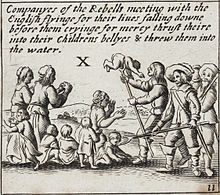
Back حرب الإحدى عشر عام Arabic Guerres confederades d'Irlanda Catalan Irske Forbundskrige Danish Irische Konföderationskriege German Guerras confederadas de Irlanda Spanish Irlandako Gerra konfederatuak Basque Guerres confédérées irlandaises French Cogadh na hAon Bhliana Déag Irish Perang Konfederasi Irlandia ID Guerre confederate irlandesi Italian
| Irish Confederate Wars or Eleven Years' War | |||||||||
|---|---|---|---|---|---|---|---|---|---|
| Part of the Wars of the Three Kingdoms | |||||||||
 Václav Hollar's engraving of supposed atrocities committed by Irish Catholics in the rebellion of 1641 | |||||||||
| |||||||||
| Belligerents | |||||||||
| Phase I: October 1641 – September 1643 | Phase I: October 1641 – September 1643 | ||||||||
| Phase II: September 1643 – June 1649 | Phase II: September 1643 – June 1649 | ||||||||
| Phase III: June 1649 – April 1653 | Phase III: June 1649 – April 1653 | ||||||||
| Commanders and leaders | |||||||||
| Phase I: | Phase I: | ||||||||
| Phase II: | Phase II: | ||||||||
| Phase III: | Phase III: | ||||||||
| Strength | |||||||||
|
| ||||||||
| Casualties and losses | |||||||||
|
| ||||||||
| Total: 200,000+ dead | |||||||||
The Irish Confederate Wars, also called the Eleven Years' War (Irish: Cogadh na hAon-déag mBliana), took place in Ireland between 1641 and 1653. It was the Irish theatre of the Wars of the Three Kingdoms, a series of civil wars in the kingdoms of Ireland, England and Scotland – all ruled by Charles I. The conflict had political, religious and ethnic aspects and was fought over governance, land ownership, religious freedom and religious discrimination. The main issues were whether Irish Catholics or British Protestants held most political power and owned most of the land, and whether Ireland would be a self-governing kingdom under Charles I or subordinate to the parliament in England. It was the most destructive conflict in Irish history and caused 200,000–600,000 deaths from fighting as well as war-related famine and disease.[2]
The war in Ireland began with a rebellion in 1641 by Irish Catholics, who tried to seize control of the English administration in Ireland. They wanted an end to anti-Catholic discrimination, to increase Irish self-governance, and to roll back the Plantations of Ireland. They also wanted to prevent an invasion by anti-Catholic English Parliamentarians and Scottish Covenanters, who were defying the king. Rebel leader Felim O'Neill claimed to be doing the king's bidding, but Charles condemned the rebellion after it broke out. The rebellion developed into an ethnic conflict between Irish Catholics on one side, and English and Scottish Protestant colonists on the other. These first few months were marked by ethnic cleansing and massacres in Ulster.
Catholic leaders formed the Irish Catholic Confederation in May 1642, which controlled and governed most of Ireland, and comprised both Gaelic and old English Catholics. In the following months and years the Confederates fought against Royalists, Parliamentarians, and an army sent by Scottish Covenanters, with all sides using scorched earth tactics. Disagreements over how to deal with the rebellion helped spark the English Civil War in mid-1642. The king authorised secret negotiations with the Confederates, resulting in a Confederate–Royalist ceasefire in September 1643 and further negotiations. In 1644, a Confederate military expedition landed in Scotland to help Royalists there. The Confederates continued to fight the Parliamentarians in Ireland, and decisively defeated the Covenanter army in the Battle of Benburb. In 1647, the Confederates suffered a string of defeats by the Parliamentarians at Dungan's Hill, Cashel and Knockanuss. This prompted the Confederates to make an agreement with the Royalists. The agreement divided the Confederates, and this infighting hampered their preparations to resist a Parliamentarian invasion.
In August 1649, a large English Parliamentarian army, led by Oliver Cromwell, invaded Ireland. It besieged and captured many towns from the Confederate–Royalist alliance. Cromwell's army massacred many soldiers and civilians after storming the towns of Drogheda and Wexford. The Confederate capital Kilkenny was captured in March 1650, and the Confederate–Royalist alliance was eventually defeated with the capture of Galway in May 1652. Confederates continued a guerrilla campaign until April 1653. This saw widespread killing of civilians and destruction of foodstuffs by the English army, who also brought an outbreak of bubonic plague.
After the war, Ireland was occupied and annexed by the English Commonwealth, a republic which lasted until 1660. Catholicism was repressed, most Catholic-owned land was confiscated, and tens of thousands of Irish rebels were sent to the Caribbean or Virginia as indentured servants or joined Catholic armies in Europe.
- ^ Mícheál Ó Siochrú/RTÉ ONE, Cromwell in Ireland Part 2. Broadcast 16 September 2008.
- ^ "The Eleven Years War 1641–52 – A Brief Overview". theirishstory.com. 10 January 2014. Retrieved 21 March 2018.